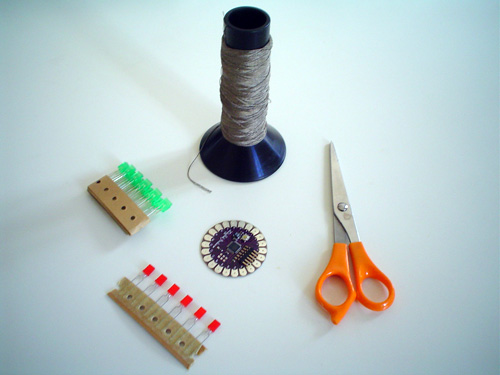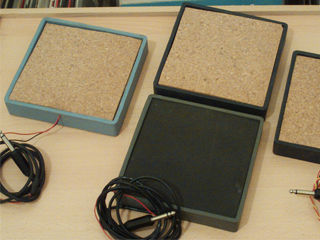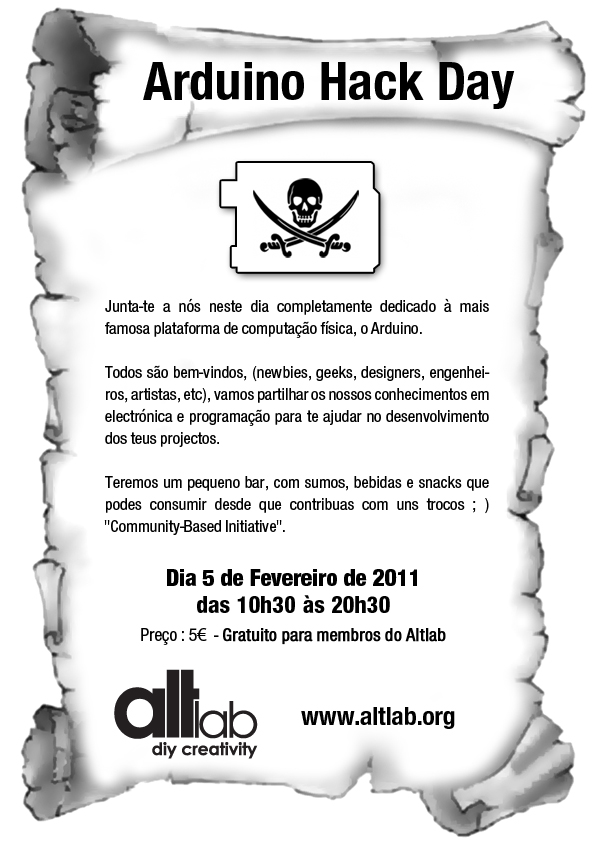| Neste workshop, com a duração de 2 dias, iremos construir sintetizadores low-tech, reactivos ao toque, capazes de produzir uma variedade de sons e texturas em função da posição, humidade e pressão dos dedos que tocarem em pontos-de-contacto destes instrumentos.
As tarefas nas quais os participantes vão ser envolvidos permitir-lhes-ão familiarizarem-se com os princípios básicos da electrónica, nomeadamente componentes, esquemas electrónicos e processo de soldagem. Não se exige experiência prévia como pré-requisito e o workshop é destinado a todos os curiosos com mais de 15 anos. Cada participante terminará o workshop com um sintetizador construído por si, que permitirá acabar com o sossego de co-habitantes, humanos, caninos ou felinos. Pede-se que os participantes tragam consigo objectos de madeira, plástico ou cartão, que possam ser furados (caixas, tupperwares, frascos, etc) nos quais pretendam alojar o seu sintetizador.
Formador: André Castro Estado: Abertas as Inscrições
Em breve em Lisboa também, no altLab é claro 🙂
|
Tag: circuit bending
Arduino Hack Day
a glove that lights up when you shake hands

This mitten lights up when its wearer shakes hands with someone. It has two exposed soft contacts around the thumb and across the palm which, when bridged by bare skin, turn on the LED embedded on the flower. The mitten itself was created by fashion designer Isabel Tomás, and we then sewed a simple touch switch circuit onto it using conductive fabric and thread. It also works with high fives and holding hands 🙂

Isabel and I designed this as a soft circuits exercise for some upcoming materials workshops. You can find all the instructions and images we prepared for this purpose @ openMaterials:
http://openmaterials.org/2010/03/03/making-a-glove-that-lights-up-with-a-hand-shake/
First Soft Circuits Open Lab

This Sunday we’re holding our first Soft Circuits Open Lab at the School of Fine Arts in Lisbon (FBAUL — Faculdade de Belas Artes de Lisboa). There is no predefined structure for the event. We will meet for the course of one day with the purposes of sharing knowledge, experimenting freely, advancing on-going projects, and just having fun working together. Some of the people attending will be specialists in electronics and others in textiles. Barcamp style impromptu presentations are very welcome.
Altlab will provide some basic tools such as pliers, scissors, soldering irons, ironing board, etc. But participants must bring all the materials and additional equipment necessary for their own projects/experiments (including laptops). Here are some suggestions: any kind of fabric, needles and thread, yarn, t‑shirts, conductive and/or resistive fabric, conductive thread, conductive and/or resistive yarn, knitting and/or crochet needles, LEDs, coin cell batteries, battery holders, EL wire, strands of fiber optics, copper foil, copper adhesive track, aluminum foil, resistive foam, regular foam, arduinos (lilypad or any other kind). If you’ve never worked with any of these materials and don’t have them handy, come anyway, you can help someone else with their project and learn along the way.
For more information on soft circuits techniques and materials, check out the Soft Circuits Resources section on the openMaterials wiki.
This open lab will take place on February 21st, from 10:30 to 18:30, at the School of Fine Arts in Lisbon, room 307, 1st floor (since our own space is still under construction). All are welcome, there is no fee nor registration, but please do let me know if you are planning on coming: catarinamota(at)audienciazero.org
Drum Pads


Hey.
Four drum pads ready to go.
All made of old material found in the Alt/Lab installations, and a very special big thankxxx for Mónica who brought the casings (we are going back to that in a moment) for the drum pads.
So the idea was to make drum pads that we could hook up to a sound card(or whatever) and them make sweet music, this is a very nice combination between piezoelectric components and a few layers of some absorbent sound material like rubber or cork foil (that’s what we use because there was nothing more) and a piece of aluminum foil for a greater drum area .
We use an old can (20l) of paint, four piezoelectric found in electronic junk like old modems and old telephones, wire for connecting the piezos, cork foil for insulation the drum pad area and Mónica supply the casings (square rubber cd´s stands), and glue for putting everything nice and tight .
First we cut a piece of the can (circular about 10cm radius)and we glued the piezo into it, then we drilled one hole into the rubber casing for the wires to came out, them we cut two square cork foil parts (the first in the bottom of the casing and the other for the top) a bit of glue and that’s it drum pads ready to rock.
Now we got some audio coming out of the pads but thats just boring because its always the same and we want to go further like transforming audio into midi messages, and we found the right tool for it, its called “KTDrumTrigger” and he transforms the audio signal into midi notes, we can use this midi notes inside a sequencer program to control any kind of instrument (either VSTI or some other stuff), in our case we use the drum pads to control “Battery” and thats it instant fun.
There are some other links and some other ideas for drum pads. This “one“uses ardunio as a source for the imput signal.



